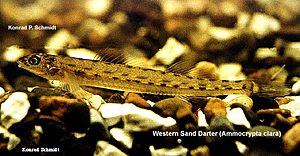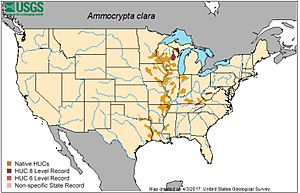Western sand darter facts for kids
Quick facts for kids Western sand darter |
|
|---|---|
 |
|
| Conservation status | |
| Scientific classification | |
| Synonyms | |
|
The western sand darter (Ammocrypta clara) is a small, slender fish that lives in freshwater. It's a type of darter, which belongs to the same fish family as perches. This fish is special because it often buries itself in the sand! You can find it in rivers across the central United States.
Contents
Where It Lives
The western sand darter lives in many river systems. You can find it from the area around Lake Michigan all the way down to Texas. It also lives in different parts of the huge Mississippi River system. Its home even stretches as far east as the Elk River in West Virginia.
What It Looks Like
This fish can grow up to about 7.1 centimeters long. That's about the length of a credit card! It has a thin, almost round body shape. The western sand darter is a pale, see-through silvery-white color. It has a yellowish color along its back. You can tell it apart from other sand darters because it doesn't have dark stripes or spots. It also has a small spine on its gill cover.
How It Lives
This fish makes its home in medium and large rivers. It likes areas with sand and gravel at the bottom. It needs loose sand because it spends a lot of time buried there. Often, only its head sticks out of the sand. This special behavior helps the fish stay cool.
What It Eats
The western sand darter eats small creatures without backbones. It especially likes to eat the young forms (larvae) of insects that live in the water.
Reproduction and Life Cycle
Western sand darters lay their eggs in the summer. In northern areas, they start in June. Farther south, they begin in May. Female fish lay about 57 eggs at a time. Bigger females can lay even more eggs.
About Its Name
The western sand darter was first officially described in 1885. Two American scientists, David Starr Jordan and Seth Eugene Meek, gave it its scientific name. They studied fish, and the first place they found this fish was in the Des Moines River in Ottumwa, Iowa. This fish is closely related to the naked sand darter and the Florida sand darter.
Why It Needs Help
The western sand darter is considered a vulnerable species. This means it's at risk of disappearing. Its homes are spread out and broken up into smaller pieces. Also, the places where it lives are getting damaged. More dirt and pollution in rivers make its habitat worse. The Mississippi River and its connected streams have many locks and dams. These structures change the river and remove places where the fish could live.
See also
 In Spanish: Ammocrypta clara para niños
In Spanish: Ammocrypta clara para niños



